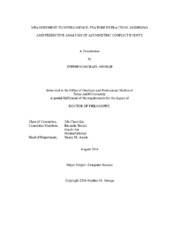| dc.contributor.advisor | Liu, Jyh-Charn | |
| dc.creator | George, Stephen M | |
| dc.date.accessioned | 2015-02-05T17:23:31Z | |
| dc.date.available | 2016-08-01T05:30:16Z | |
| dc.date.created | 2014-08 | |
| dc.date.issued | 2014-06-06 | |
| dc.date.submitted | August 2014 | |
| dc.identifier.uri | https://hdl.handle.net/1969.1/153293 | |
| dc.description.abstract | The conflict events that comprise asymmetric warfare are a primary killer of both combatants and civilians on the modern battlefield. Improvised explosive devices (IED) and direct fire (DF), the most common of these attacks, claim thousands of lives as conventional and unconventional forces clash. Computer-based predictive analysis can be used to identify locations that are useful for these events, potentially providing the awareness needed to disrupt or avoid attacks before they are launched.
In this dissertation, I propose an analytical framework for predictive analysis of asymmetric conflict events. This framework incorporates a tactics-aware system model based on attacker roles that is populated with a set of geomorphometric and visibility-constrained features describing terrain and proximity to necessary supporting structures. Features that identify and assess the utility of terrain for use by risk-averse attackers are important contributors to the model. Statistical learning is used to extract spatially and temporally constrained tactical patterns. These patterns are then used to predict the utility of future or unvisited locations for conflict events.
Major contributions of this dissertation include:
(1) A concise, accurate feature representation of conflict events in non-urban environments;
(2) A system model based on attacker roles that captures the tactical patterns of conflict events;
(3) Accurate conflict event classification algorithms that support predictive analysis; and
(4) A novel method for detecting and describing features that support risk-averse attackers.
The framework has been implemented and tested on real-world IED and DF data collected from the conflict in Afghanistan in 2011-2012. Several learning techniques are assessed using two dimensionality reduction schemes under a variety of spatial, temporal and combined constraints. A resource-unconstrained version of the framework accurately predicts conflict events across a wide range of terrain types and over the 19 months covered by available data. A limited version of the framework that assumes less computational capability provides useful predictive analysis that can be performed in mobile and resource constrained environments. | en |
| dc.format.mimetype | application/pdf | |
| dc.language.iso | en | |
| dc.subject | improvised explosive device | en |
| dc.subject | asymmetric warfare | en |
| dc.subject | machine learning | en |
| dc.subject | geomorphometry | en |
| dc.subject | feature extraction | en |
| dc.subject | risk aversion | en |
| dc.subject | Afghanistan | en |
| dc.title | Measurement to Intelligence: Feature Extraction, Modeling and Predictive Analysis of Asymmetric Conflict Events | en |
| dc.type | Thesis | en |
| thesis.degree.department | Computer Science and Engineering | en |
| thesis.degree.discipline | Computer Science | en |
| thesis.degree.grantor | Texas A & M University | en |
| thesis.degree.name | Doctor of Philosophy | en |
| thesis.degree.level | Doctoral | en |
| dc.contributor.committeeMember | Bettati, Riccardo | |
| dc.contributor.committeeMember | Gu, Guofei | |
| dc.contributor.committeeMember | Bishop, Michael | |
| dc.type.material | text | en |
| dc.date.updated | 2015-02-05T17:23:31Z | |
| local.embargo.terms | 2016-08-01 | |
| local.etdauthor.orcid | 0000-0001-9011-2097 | |


